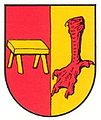Goose (heraldic animal)
As a heraldic animal , the goose is a common figure and stands out from the many other animals because of the importance of its attributes.
It is modeled on the white domestic goose . The stylization of the natural form is slight. As " Martin's goose" it is a distinguishing mark of Saint Martin of Tours . Your representation is in the coat of arms with the line of sight to the heraldic right and on both feet. Body color is shown in white and the beak and feet are shown primarily in red or gold. The wings are generally donned or ready for flight. Often the portrayal of a goose flying up or held by another heraldic figure (e.g. human). Swimming on a lake, she can be in the coat of arms. The representation in the coat of arms as a helmet ornament is also popular .
The goose can also be crowned or crowned in the coat of arms. Many coats of arms only show the webbed legs instead of a whole bird. Here this form is symbolic in coats of arms. Also only goose heads are shown in the coat of arms. The arrangement is often made in three passages. As the talking coat of arms of the Gans zu Putlitz , that of von Gans , that of Dieskau and that of Geusau .
The family coat of arms of the reformer Jan Hus (around 1369–1415) was also a goose; Hus means goose in Czech . Before his execution he is said to have said: "Today you are roasting a goose, but a swan will arise from the ashes ". This was related to Martin Luther and therefore made the swan his attribute. Luther himself used as a seal of the Luther Rose and no swan arms .
The goose foot cross has stylized goose feet at its cross arms.
Examples
Ganter in the coat of arms of Ganderkesee , Lower Saxony
The goose in the shield and coat of arms of Putlitz , Brandenburg
Goosefoot in the coat of arms of Böbingen , Rhineland-Palatinate
Coat of arms of Neuermark-Lübars , Saxony-Anhalt
Goose on field : Goosefeld , Schleswig-Holstein
Talking coat of arms in Gänserndorf , Lower Austria
Coat of arms of Wülflingen , Canton of Zurich







